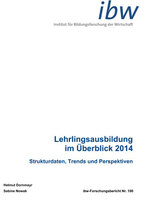Die seit dem Jahr 2000 jährlich erscheinende (von BMWFW und WKÖ geförderte) ibw-Publikation „Lehrlingsausbildung im Überblick“ zeigt einen aktuellen Querschnitt über die Lehrlingsausbildung in Österreich. Neben den vielfältigen Erfolgen und Stärken der Lehrlingsausbildung (z.B. bei der Verringerung der Jugendarbeitslosigkeit, den Einstiegseinkommen oder der Förderung von selbständiger Erwerbstätigkeit) werden auch aktuelle Problemlagen illustriert: Insbesonders der vor allem demographisch bedingte starke Rückgang an Lehrlingen und Lehrbetrieben gibt Anlass zur Sorge betreffend die Sicherung des zukünftigen Fachkräftebedarfs in Österreich.
Bestellung der Print-Ausgabe für einen Druckkostenbeitrag von 15 Euro (exkl. Versandspesenpauschale) unter info@ibw.at.
The ibw “Survey of Apprenticeship Training” study, which has been published every year since 2000 (with funding provided by the Federal Ministry of Science, Research and Economy BMWFW and the Austrian Federal Economic Chamber WKÖ), provides an overview of the current Situation of apprenticeship training in Austria. As well as the varied successes and strengths of apprenticeship training (such as the reduction of youth unemployment, entry-level incomes or encouragement of selfemployment), current problems are also illustrated: The strong decline in the number of apprentices and training companies (which is mainly due to demographic reasons) in particular gives rise to concern about how to guarantee the future demand for skilled workers in Austria.
